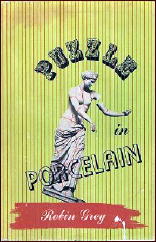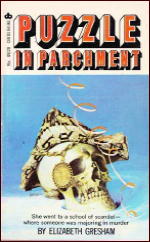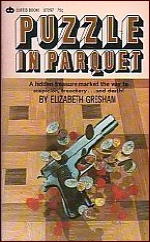Mon 9 Dec 2013
Reviewed by William F. Deeck: ELIZABETH GRESHAM – Puzzle in Porcelain.
Posted by Steve under Authors , Bibliographies, Lists & Checklists , Characters , Reviews[4] Comments
William F. Deeck
ELIZABETH GRESHAM – Puzzle in Porcelain. Duell Sloan & Pearce, 1945. Bart House #29, paperback, June 1946. Curtis, paperback, no date [1973]. See also below.

Tom Pottle comes to Hunter Lewis, a tinkerer or handyman, to get a statue of Psyche repaired. Pottle had bent over in his garden and something hissed by him and struck the porcelain statue doing a fair amount of damage. A young man, something of a natural, who lives in the woods and cares for animals of all kinds is blamed for the shattering of the statue.
Pott!e is a cad, a scoundrel, a bounder, a parvenu, a philanderer, and, much worse, a Northerner who has settled near Richmond, Virginia, and has social and power ambitions. When Lewis goes to see the remains of the statue the next day, he discovers that Pott!e has been found dead at his doorstep, the victim of a rattlesnake bite, Lewis notes some oddities in the death and gets the local police interested.
When the young man who lives in the woods dies shortly thereafter — suicide maybe — the police are convinced that Pott!e was really bitten by a snake, probably handled by the young man. Lewis is unconvinced, and he and Jenny Gilette, a young lady hopelessly, or so it would seem, in love with him, continue to seek out the real story.
Gilette is the first person narrator of the proceedings and makes for a good Watson. She and Lewis are an interesting and enjoyable pair. The novel is mostly fair play, with the clues, though not the motive, necessary to figure it out along with Lewis.
There is something of a mystery about Elizabeth Gresham. Puzzle in Porcelain was published in 1945 as by Robin Grey. Another novel under that name was published in 1947, and then came a long silence, broken finally in 1972, 25 years later, with the publication of Puzzle in Paisley and the republication in paperback of her first two novels, this time under her real name.
Paisley is a gothic-type novel, which nonetheless features Jenny Gilette and, to a small extent, Hunter Lewis. Like Porcelain, it has no specific period setting; both could have taken place at any point, except for the Second World War years, from the ’20s to the ’50s and maybe even ’60s.
The Jenny Gilette & Hunter Lewis series —
As by Robin Grey:
Puzzle in Porcelain (n.) Duell 1945
Puzzle in Pewter (n.) Duell 1947
As by Elizabeth Gresham:
Puzzle in Paisley (n.) Curtis 1972
Puzzle in Parchment (n.) Curtis 1973

Puzzle in Parquet (n.) Curtis 1973

Puzzle in Patchwork (n.) Curtis 1973
The author has five other entries in Hubin’s Crime Fiction IV, one indicated as marginally criminous, all from the late 1970s when she was in her seventies, and from the titles, probably romantic suspense novels (Gothics), at their height of popularity at the time.
December 9th, 2013 at 6:34 pm
There’s a mystery here that I don’t have the answer to, nor has a quick search on the Internet come with anything either. Why, is the question, was there a 25 year gap between the two installments of the series, and then — bang, bang, bang, bang — all of a sudden four books in two years?
One suspects that Gresham had the books written but no publisher for them until Curtis, a small and all but obscure paperback publisher in the 1970s, came along and made her a deal.
Same thing happened with Mike Avallone and several of his Ed Noon PI novels, in pretty much the same time period.
December 9th, 2013 at 8:00 pm
And by the way, add this to this month’s list of series I’ve always meant to sample and never have.
Looking on from the outside, though, this appears to be the kind of series that a publisher such as Rue Morgue Press ought to be looking into. Hubin reveals something else of interest, perhaps: in his CRIME FICTION IV he lists the female half of the detective-solving team as Jenny Gilette (Lewis).
December 10th, 2013 at 11:11 am
How very strange. I was going to read and review this very book for my blog in January. Probably still will. The cover of my Bart Books paperback edition makes it very enticing — more so than this sketchy review of Bill’s. Maybe you ought to add to the bibliographic data above: Bart House, #29, June 1946.
Your guess about the books already having been written makes a lot of sense, Steve. Especially given Bill’s remark about the lack of specificity regarding time period.
December 10th, 2013 at 1:34 pm
I hope you do go ahead and review it, John. Another take on the book would be welcome, at least by me. Sometimes Bill’s reviews are a little too short and concise and don’t always answer a question I’d love to be able to ask him.
And thanks for the data on the Bart House edition. I’ll add it to the original post right away.